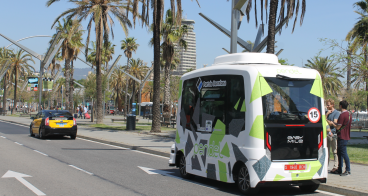Closing the autonomous gap: how to lead autonomous driving to success
Autonomous driving is the future of mobility. This revolution will affect various industries, including automotive OEMs, suppliers, mobility service providers and public transit operators. With billions of dollars invested over the past decade by venture capitalists, technology companies, automotive manufacturers and private equity firms enormous progress has been made towards autonomous systems. However, there are still significant gaps on the path to scaled use of autonomous systems and it is essential to understand the complexity of developing autonomous systems.
Based on the joint study "The Autonomous Gap" with Fraunhofer IAO (Centre for Mobility and Innovation Systems) and Motor Presse Stuttgart, MHP - A Porsche Company has developed a whitepaper which paints a clear picture of where leading stakeholders in the mobility and automotive value chain should take action to close gaps in order to develop sustainable and successful ecosystems for autonomous mobility.
Several paths lead to autonomous mobility and transportation services
The paper identifies several pathways leading to autonomous mobility and transportation services. On the one hand, traditional automotive manufacturers are taking incremental approaches towards highly automated and autonomous driving: SAE level 2 and 3 solutions are already available on the market, with the aim of improving their functions to achieve level 4 within the next decade. On the other hand, leading technology companies are ambitiously developing complex solutions for level 4 from scratch. The “moonshot approach”, aiming for level 4 from the beginning, requires enormous amounts of funding. Companies like Waymo or Cruise have raised billions of dollars to develop technology for autonomous systems.
Identify and close existing gaps for sustainable autonomous mobility systems
There are significant gaps on the path to scaled deployment of autonomous systems. In total, eight gaps were identified and mapped to the different parts of the ecosystem. These gaps, which occur in individual systems and at their interfaces, must be closed in order for comprehensive autonomous mobility and transport systems to emerge. The gaps themselves are the result of discrepancies between user expectations and emerging developments in technology and services. Possible options for closing the gaps by the activities of the different stakeholders are providing a guidance on the way to successful deployments.
Derive a strategy that overlaps with skills and resources
To be successful, all stakeholders need to assess their existing expertise, set realistic goals and allocate appropriate resources. The success of such a reorientation also depends on the willingness of companies to question existing structures and take advantage of specific market opportunities. Vehicle manufacturers have the opportunity to become operators of autonomous fleets in addition to developing and providing vehicles. Based on our study results, however, we do not see any economically sustainable opportunity for automotive OEMs to occupy the customer interface. Established mobility platforms, for their part, can expand their offerings with digital value-added services and a holistic user experience, while also taking over the operation of autonomous fleets. In addition to mobility platforms, today’s public transport operators in particular are already well positioned for future autonomous mobility offerings. PTOs enjoy a high level of trust across all markets, as the survey (5,000 participants) related to the joint study with Fraunhofer IAO has concluded. A share of 39 % of respondents would trust a public transit operator as a provider of autonomous mobility services.
Ecosystems thinking as key for autonomous mobility systems
Autonomous mobility and transport solutions must be designed as customer-centric ecosystems to be successful. The collaboration of partners and stakeholders with various capabilities is essential to create services that meet customer needs. The complexity of the individual areas of the ecosystems is too high for a single company to manage alone. Success in autonomous mobility depends on the formation of ecosystems. The formation of partnerships and ecosystems at eye level is crucial for success.
Think regional - autonomous mobility is hyperlocal
As the development and implementation of digital mobility with autonomous systems will be hyperlocal, region-specific use cases are crucial. There is no one-size-fits-all solution when it comes to vehicle types, technical systems, partnerships in ecosystems and use cases. User requirements and the expected mobility use cases are inherently different from region to region. Furthermore, stakeholders differ from region to region, starting with platforms and digital ecosystems that users use to book mobility and make the time before, during and after their journey as pleasant as possible. In addition, there are also regional differences in the players involved in fleet operation and the providers of vehicles and autonomous systems.
Access the full whitepaper in the shared files section below to discover all of the eight gaps identified.
Augustin Friedel has teamed up with Marcus Willand and Dr. Nils Schaupensteiner. They are experts and trusted advisors for the mobility transformation and the definition of autonomous driving systems. MHP’s Mobility Transformation Team works with companies, solution providers and cities to shape today's mobility challenges and prepare for the future. Thanks to our competencies and network at MHP, clients can work with us to create concepts and implement solutions for mobility budgets. We work with our clients early on to develop the vision and strategy based on our deep industry knowledge and expertise. Together with the stakeholders, we create an implementation roadmap to achieve the project goals.
Published on 26 April 2023.






